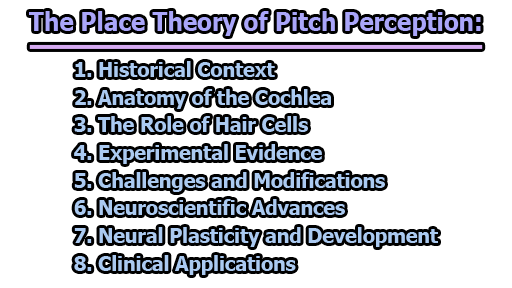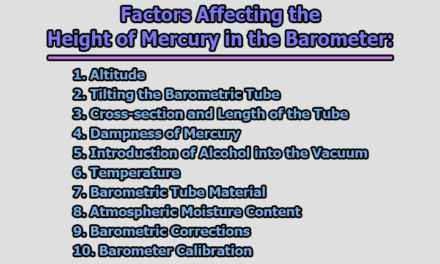The Place Theory of Pitch Perception:
Pitch perception is a fundamental aspect of auditory sensation, allowing us to distinguish between high and low tones in the complex world of sound. The Place Theory of Pitch Perception is a prominent framework that delves into the mechanisms underlying our ability to perceive pitch. Proposed by Hermann von Helmholtz in the 19th century, this theory has been foundational in understanding how our auditory system processes different frequencies and translates them into the rich tapestry of musical notes and everyday sounds. In this article, we will explore the intricacies of the Place Theory, its historical roots, experimental evidence, and its relevance in contemporary neuroscience.
1. Historical Context: The roots of the Place Theory can be traced back to Hermann von Helmholtz, a prominent German physicist and physician whose groundbreaking work, “On the Sensations of Tone” (1863), laid the foundation for our understanding of auditory perception. Helmholtz proposed that pitch perception is intimately tied to the location on the basilar membrane in the cochlea that resonates in response to different frequencies. According to Helmholtz, higher frequencies stimulate specific regions near the base of the cochlea, while lower frequencies excite areas towards the apex.
Helmholtz’s insights were based on meticulous observations and experiments, including his use of resonators and tuning forks to isolate and manipulate specific frequencies. His work marked a paradigm shift in our comprehension of auditory processes, setting the stage for the development of the Place Theory.
2. Anatomy of the Cochlea: To delve into the Place Theory, it is imperative to grasp the intricate anatomy of the cochlea, the spiral-shaped structure within the inner ear responsible for converting sound waves into neural signals. The cochlea comprises three primary chambers: the scala vestibuli, the scala media, and the scala tympani. Within the scala media resides the organ of Corti, a complex structure housing hair cells – the primary sensory receptors for hearing.
The pivotal role of hair cells in pitch perception becomes apparent when sound waves reach the ear. These waves induce vibrations in the fluid within the cochlea, subsequently transmitted to the basilar membrane. The organ of Corti, situated atop the basilar membrane, contains thousands of hair cells with stereocilia, hair-like structures. As the basilar membrane flexes, the stereocilia are deflected, generating electrical signals that are transmitted to the auditory nerve and, ultimately, to the brain.
3. The Role of Hair Cells: Hair cells play a central role in the Place Theory, acting as transducers that convert mechanical vibrations into electrical signals. When sound waves cause the basilar membrane to flex, specific hair cells are activated based on the frequency of the incoming sound. Importantly, the spatial arrangement of hair cells along the basilar membrane corresponds to a tonotopic map, where specific regions are more responsive to certain frequencies.
The tonotopic mapping proposed by the Place Theory establishes a spatial code for pitch perception. Higher frequencies lead to greater displacement of the basilar membrane near the base of the cochlea, activating hair cells in that region. Conversely, lower frequencies stimulate areas closer to the apex. This spatial encoding allows the brain to interpret different pitches based on the location of hair cell activation, forming the core tenet of the Place Theory.
Understanding the intricate interplay between sound waves, the basilar membrane, and hair cells provides a solid foundation for comprehending the Place Theory’s proposition that pitch perception is intricately tied to the physical location of stimulation along the cochlea. In the subsequent sections, we will delve further into experimental evidence, challenges, modifications, and the contemporary implications of the Place Theory in the realm of auditory neuroscience.
4. Experimental Evidence: The Place Theory’s validity is supported by a wealth of experimental evidence that has been crucial in shaping our understanding of pitch perception. One notable experiment involved the insertion of electrodes along the length of the basilar membrane. This method allowed researchers to directly stimulate specific regions and observe the resulting perception of pitch. When different regions were electrically stimulated, subjects consistently reported perceiving different pitches, providing direct and compelling evidence for the spatial encoding of pitch along the cochlea.
Moreover, cochlear implants, designed to restore hearing in individuals with hearing loss, have served as practical demonstrations of the Place Theory. By carefully adjusting the electrodes in these implants to target specific regions of the cochlea, researchers effectively mimic the tonotopic mapping proposed by the theory. Users of cochlear implants, therefore, are able to perceive different pitches, reinforcing the idea that stimulating specific regions along the cochlea leads to distinct perceptions of pitch.
These experiments not only validate the Place Theory but also have practical implications in the development of technologies aimed at restoring or enhancing auditory experiences. The ability to manipulate specific regions of the cochlea to produce discernible pitches opens new possibilities for treating hearing impairments and designing advanced auditory prosthetics.
5. Challenges and Modifications: While the Place Theory has significantly contributed to our understanding of pitch perception, it faces challenges and has undergone modifications to address emerging complexities. One challenge arises from the observation that the basilar membrane’s structure is not uniform; it becomes wider and more flexible towards the apex. This non-uniformity challenges the theory’s initial proposal of a strict tonotopic mapping based solely on physical characteristics.
In response to these challenges, modifications to the Place Theory have been suggested. One such modification is the Volley Theory, which posits that groups of neurons can work together to encode the frequency of a sound. This cooperative mechanism allows for a more nuanced understanding of pitch perception, accounting for the non-uniformity of the basilar membrane and providing a more comprehensive model that considers multiple factors influencing auditory processing.
The dynamic nature of auditory perception, as evidenced by these challenges and modifications, underscores the ongoing evolution of our understanding of the complex mechanisms involved in pitch perception. It prompts researchers to explore additional dimensions beyond the spatial encoding proposed by the original Place Theory.
6. Neuroscientific Advances: Recent advances in neuroimaging techniques, such as functional magnetic resonance imaging (fMRI) and magnetoencephalography (MEG), have enabled researchers to explore the neural correlates of pitch perception. These studies provide valuable insights into how the auditory cortex processes information from the cochlea and how different regions contribute to the overall perception of pitch.
Neuroimaging has facilitated a more comprehensive examination of the neural pathways involved in pitch processing. It allows researchers to visualize and quantify brain activity associated with different frequencies, offering a deeper understanding of the intricate neural networks responsible for translating physical sound stimuli into the perceived richness of pitch.
These neuroscientific advances not only validate the Place Theory but also contribute to a broader comprehension of the brain’s role in auditory processing. The integration of imaging technologies with experimental methodologies has opened new avenues for investigating the neural intricacies underlying pitch perception, bringing us closer to a holistic understanding of the auditory system.
7. Neural Plasticity and Development: The Place Theory intersects with the concept of neural plasticity, which refers to the brain’s ability to reorganize itself in response to experience. This phenomenon has significant implications for our understanding of how the auditory system develops and adapts over time. Studies have demonstrated that the tonotopic map on the cochlea is not fixed but can undergo changes based on sensory input.
For example, exposure to specific frequencies or alterations in auditory experiences can lead to adaptations in the tonotopic map. This plasticity allows the auditory system to adjust to changing environmental conditions, highlighting the dynamic nature of pitch perception. Understanding neural plasticity in the context of the Place Theory provides insights into the mechanisms that underlie learning, memory, and the long-term effects of auditory experiences on the organization of the auditory cortex.
8. Clinical Applications: The Place Theory’s practical applications extend to the field of clinical interventions, particularly in the development of cochlear implants and other auditory prosthetics. Cochlear implants, designed to address severe hearing loss by directly stimulating the auditory nerve, rely on the principles of the Place Theory to provide users with a sense of pitch.
By strategically placing electrodes within the cochlea to correspond to specific frequency regions, cochlear implants can effectively mimic the tonotopic mapping proposed by the Place Theory. This allows individuals with hearing impairments to perceive different pitches and, consequently, experience a more comprehensive auditory environment. The success of cochlear implants underscores the clinical relevance of the Place Theory and its role in improving the quality of life for those with hearing disabilities.
Additionally, the insights gained from the Place Theory contribute to the development of other auditory prosthetics and assistive devices. Researchers and engineers can leverage the understanding of spatial encoding along the cochlea to design technologies that better emulate natural auditory processes. As advancements in neurotechnology continue, the Place Theory remains a guiding principle in creating innovative solutions for individuals with hearing challenges.
In conclusion, the Place Theory of Pitch Perception stands as a pivotal framework that has shaped our understanding of how the auditory system processes different frequencies. From its historical roots in Helmholtz’s work to contemporary neuroscientific research, this theory has provided valuable insights into the spatial encoding of pitch along the cochlea. Experimental evidence, challenges, modifications, neuroscientific advances, and clinical applications collectively highlight the enduring relevance and significance of the Place Theory in unraveling the intricacies of auditory perception.
As our knowledge of the auditory system continues to advance, the Place Theory remains a cornerstone in the exploration of pitch perception. The symphony of sound, with its dynamic interplay of frequencies and neural responses, continues to reveal its complex and fascinating composition. The Place Theory serves as a guide, offering a roadmap for understanding how the brain transforms physical vibrations into the rich tapestry of auditory experiences that shape our perception of the world.

Library Lecturer at Nurul Amin Degree College










